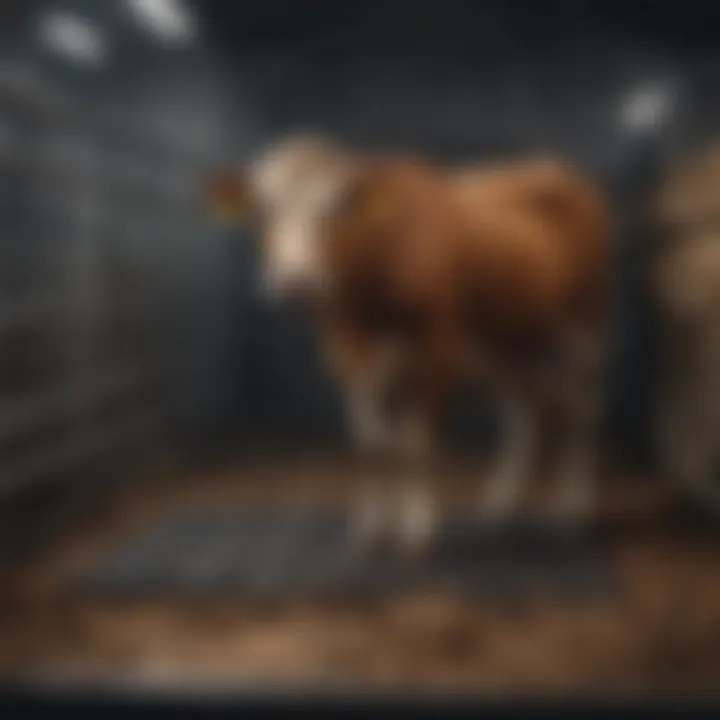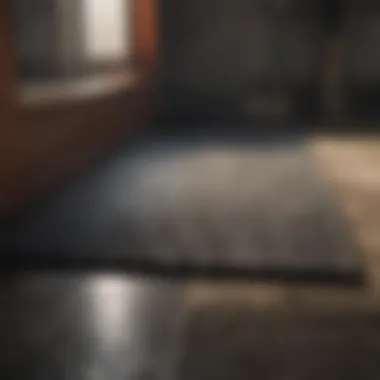The Importance and Impact of Wash Stall Mats in Agriculture


Intro
In the agricultural sector, the utilization of wash stall mats serves a critical role, extending beyond mere flooring solutions. These mats provide essential support for hygiene, comfort, and sustainability in farming operations. Their significance becomes even clearer when considering the welfare of livestock and the overall efficiency of farm management.
As various types of mats emerge in the market, understanding their composition and application helps farmers make informed choices. Additionally, regular maintenance becomes crucial in ensuring these mats perform their intended functions over the long term.
Topic Overview
Definition and Importance
Wash stall mats are specially designed rubber, foam, or plastic mats placed in areas where livestock are washed or cleaned. Their primary purpose is to enhance the cleanliness and comfort of the animals while also protecting the underlying surface from wear and tear. Moreover, these mats improve safety by preventing slips and falls during cleaning processes.
Key advantages of wash stall mats include:
- Improved hygiene for livestock
- Enhanced comfort during washing
- Reduction of injuries from slipping
- Longevity of facility floors
Brief History and Evolution
The concept of wash stall mats emerged alongside advancements in animal husbandry practices. Early farm setups often neglected the importance of cleanliness and comfort, leading to poor livestock health. As awareness of the link between hygiene and animal welfare grew, wash stall mats were developed to address these challenges. From basic rubber materials, the market has evolved to include specialized mats offering better drainage, cushioning, and durability.
Their development reflects a broader trend in agriculture toward adopting practices that not only support animal well-being but also enhance operational sustainability. Farmers are progressively recognizing that investing in these mats is integral to maintaining both productivity and animal health.
Practical Applications
Step-by-Step Guides
Implementing wash stall mats effectively requires careful consideration of several factors:
- Selecting the Right Material: Choose mats made from high-quality rubber or foam that provide adequate grip and cushioning.
- Preparation of the Installation Area: Ensure the flooring is clean, dry, and level before laying down the mats.
- Installation: Roll out the mats snugly to eliminate gaps. Ensure proper drainage and that mats are firmly secured to avoid movement.
- Routine Maintenance: Regular cleaning with appropriate detergents will preserve hygiene. Inspect mats periodically for damage and replace them as needed.
"Investing in wash stall mats not only enhances animal welfare but also reflects a farmer’s commitment to sustainable practices."
Case Studies or Real-World Examples
Multiple farms have reported significant improvements in animal health and farm efficiency after installing wash stall mats. For instance, a dairy farm in Pennsylvania saw a 20% decrease in respiratory issues among calves after replacing concrete surfaces with mats in wash areas. Similarly, a cattle ranch in Texas noted that the overall injury rates dropped significantly, attributing this change directly to the adoption of wash stall mats.
In summary, as agriculture continues to evolve, the importance of wash stall mats becomes more pronounced, necessitating a deeper understanding among farmers and stakeholders about their benefits and maintenance.
Prolusion to Wash Stall Mats
Wash stall mats play a vital role in the agricultural landscape, serving as implementations that improve hygiene, comfort, and safety for livestock. Their significance extends beyond mere functionality; they also contribute to the overall efficiency of agricultural operations.
Understanding the importance of wash stall mats begins with acknowledging their core purpose: to provide a clean, stable, and safe environment for animals during washing or grooming processes. These mats are engineered to withstand regular use in moist and potentially unhygienic settings, offering a reliable surface to prevent slips and falls.
Moreover, wash stall mats can enhance the welfare of animals by providing a cushioned surface that reduces fatigue and discomfort. For farmers and animal handlers, this means healthier livestock and better performance in their respective roles.
Key considerations when incorporating wash stall mats include:
- Material Selection: The choice of materials directly impacts durability and hygiene.
- Design Features: Texture and drainage systems play a role in reducing cleaning times and preventing mold or bacteria accumulation.
- Maintenance Needs: Understanding how to clean and maintain these mats ensures their longevity and effectiveness.
Utilizing wash stall mats can also have significant economic implications. Although the initial investment may seem daunting, the long-term benefits, including reduced veterinary costs and improved productivity, often outweigh the costs.
In summary, the incorporation of wash stall mats in agricultural settings can enhance not only the immediate environment for livestock but also the overall efficiency and profitability of farm operations. This article intends to dissect each aspect surrounding wash stall mats, providing clear insights into their materials, maintenance, and more.
Understanding Wash Stall Mats
Wash stall mats play a crucial role in the management of agricultural environments. They are specifically designed to provide a comfortable and safe surface within livestock facilities, veterinary clinics, and equestrian areas. Understanding these mats involves examining their definition, materials used, and design features. Each of these aspects contributes significantly to their effectiveness and utility in agricultural settings.
Definition and Purpose
Wash stall mats are flooring solutions meant to create a hygienic and safe environment for livestock during washing and grooming processes. They facilitate not only cleanliness but also contribute to the overall comfort of the animals. The main purpose of these mats is to minimize the risk of slips and falls, making it easier to clean and maintain the space.
Materials Used
Rubber
Rubber is a commonly used material for wash stall mats due to its durability and resilience. A key characteristic of rubber is its ability to absorb shock, which aids in reducing stress on animals' joints. This makes it a popular choice for equestrian centers and livestock facilities as it enhances comfort during standing and movement.
One unique feature of rubber mats is their non-slip surface, which can significantly lower the chances of accidents in wet conditions. However, they can be heavier and more challenging to install compared to lighter materials.
EVA Foam
EVA foam is gaining traction as a wash stall mat material for its lightweight and cushioning properties. It is beneficial because it provides a soft surface that reduces fatigue in both animals and handlers. Its key characteristic is its flexibility, allowing it to adapt to different shapes and surfaces.
The unique feature of EVA foam is its resistance to moisture, making it easy to clean and maintain. On the downside, while it offers comfort, its longevity might not match that of rubber in high-traffic areas.
Plastic
Plastic mats are another alternative used in wash stalls. They are often chosen for their affordability and lightweight nature. The key characteristic of plastic mats is their ease of installation and versatility, as they can be manufactured in various designs and thicknesses.
A defining feature of plastic mats is their resistance to chemical cleaners, enabling easier sanitation. However, plastic mats may not provide the same level of cushioning as rubber or EVA foam, which could impact animal comfort.


Design Features
Texture
The texture of wash stall mats plays a vital role in their efficiency. A textured surface enhances grip, reducing the likelihood of slips, particularly in wet environments. This key characteristic of textured mats is essential for ensuring animal safety.
One unique feature of texture is how it can influence cleaning. While textured mats can trap dirt and debris, proper cleaning processes can mitigate this issue, ensuring hygiene is maintained.
Drainage Systems
Drainage systems integrated into wash stall mats are crucial for maintaining cleanliness. A key characteristic of these systems is their ability to channel water away from the surface, preventing pooling that could lead to slips. Implementing effective drainage makes it easier for handlers to maintain a dry and sanitary environment.
The key benefit of having an effective drainage system is reduced labor costs for cleaning, as fewer resources are needed to dry the area after washing.
Thickness
The thickness of wash stall mats can vary, influencing both comfort and durability. A thicker mat provides better shock absorption, benefiting animal welfare by reducing joint stress. The key characteristic of thickness is also tied to longevity—thicker mats are generally more durable.
However, thicker mats can become cumbersome, making installation and movement more difficult. It's essential to balance comfort and practical considerations when choosing mat thickness.
Benefits of Wash Stall Mats
Wash stall mats offer a range of benfits that are pivotal in fostering better agricultural conditions. These mats are much more than just a protective layer; they significantly enhance hygiene, animal welfare, and operational efficiency within agricultural settings. Understanding these benfits can help farmers choose the right options for their specific needs. Each key aspect of the advantages provided by wash stall mats contributes to a more sustainable and productive farming practice.
Hygiene Improvement
Maintaining a high standard of hygiene is crucial in agricultural industries. Wash stall mats aid in achieving that by providing a surface that is easier to clean and sanitize. They prevent the accumulation of mud, manure, and other pathogens that can harm livestock health and productivity.
By using these mats, farmers can ensure that every wash down is effective, leading to reduced bacterial presence. This enhances the overall environment for animals, minimizing disease risk and promoting better growth and health outcomes. Furthermore, mats like those made of rubber or EVA foam are resistant to moisture, further preventing the growth of unwanted microbes.
Animal Comfort and Welfare
Animal comfort is closely linked to their wellbeing and productivity. Wash stall mats, with their cushioned surfaces, offer relief to the animals, especially when they have to stand for long periods. Comfort mats are designed to absorb some impact, which helps in reducing joint stress.
When animals are comfortable, they exhibit better behavior, which can lead to improved health and productivity. A comfortable animal is less likely to suffer from stress, which is known to impact growth rates and milk production negatively. Therefore, investing in mats that prioritize animal comfort is not just a matter of ethics but also a matter of enhanced yields.
Ease of Cleaning
The design of wash stall mats facilitates quick and effective cleaning. Their smooth surfaces prevent debris from sticking, thus, maintaining a cleaner environment becomes a less labor-intensive task. In addition, mats are generally resistant to stains and odors, making it easy to keep facilities fresh.
Routine cleaning schedules can be efficiently implemented without much disruption to daily operations. For farms that handle large volumes of animals, this ease translates into significant time savings, allowing farmers to focus on more critical tasks rather than extensive cleaning routines.
Reduction of Slips and Falls
Safety is a top priority in any farming setting. Wash stall mats provide a non-slip surface that significantly reduces the potential for accidents. Animals, especially when wet, can easily slip on untreated surfaces, leading to injuries.
By incorporating mats with effective drainage systems, water can flow away quickly, preventing puddling. Investing in quality mats ensures that both the animals and the staff can operate in a safer environment. Less slip and fall incidents can directly translate into lower insurance costs and a more efficient working environment.
Applications in Agricultural Settings
Wash stall mats play a crucial role in various agricultural settings. Their applications are diverse and significantly enhance both functionality and welfare of livestock. From livestock facilities to veterinary clinics and equestrian areas, these mats are indispensable. Understanding their importance and impact leads to better decisions in facility management.
Livestock Facilities
In livestock facilities, wash stall mats serve multiple purposes. They provide a non-slip surface that ensures the safety of animals during washing and grooming. This reduces risks of injuries that can arise from slips and falls. Additionally, wash stall mats are designed to drain excess water effectively. This drainage helps prevent conditions that can lead to hoof diseases, which are common in wet environments. Additionally, the right mats can simplify the cleaning process, making daily maintenance easier for farmers.
The mats also contribute to improved herd health. They create a more comfortable environment for animals while they are washed, preventing stress. Comfort translates to better overall well-being, which can have favorable effects on productivity. Furthermore, having clean and dry areas helps in controlling the spread of disease
Veterinary Clinics
In veterinary clinics, the importance of wash stall mats cannot be overstated. They provide a hygienic area for the treatment of animals. The mats aid in maintaining cleanliness during procedures, which is essential in preventing infections. Facilities that invest in good quality mats often see a reduction in wear and tear on floors. The non-slip surface is also critical for the safety of both animals and veterinary staff. In addition, mats with good drainage systems keep the area less messy, allowing for better focus on care rather than cleaning up spills.
Moreover, using mats can impact the emotional state of animals in a veterinary clinic. Animals that feel secure and comfortable are less likely to experience stress. This can lead to smoother examinations and treatments, enhancing the workflow of the clinic.
Equestrian Areas
Equestrian areas are another vital application for wash stall mats. In these spaces, mats provide a safe, comfortable ground for horses during washing, grooming, and other activities. The texture of the mats ensures traction, which is essential for the safety of both the horse and the handler. Well-designed mats can absorb shock, minimizing fatigue on the horse’s limbs and joints.
Furthermore, in equestrian settings, wash stall mats contribute to the overall appearance and cleanliness of the facility, enhancing the experience for owners and visitors alike. With options available that are easy to install and maintain, they support both the aesthetics and functionality of equestrian practices. In addition, like in livestock facilities, the mats promote hygiene in equestrian areas, significantly reducing the risk of ailments common amongst horses in wet environments.
Overall, the applications of wash stall mats in agriculture are key to promoting health, safety, and efficiency in various animal care settings.
Selecting the Right Wash Stall Mats
Selecting appropriate wash stall mats is a critical aspect of ensuring optimal conditions in agricultural settings. The right mats contribute to hygiene, animal welfare, and long-term sustainability. Choosing the correct size, material, and budget can significantly impact functionality and usability.
Considerations for Size and Shape
When choosing wash stall mats, understanding the size and shape of the area is essential. Mats should cover the entire space where livestock will stand or walk. If the mats are too small, they may not provide the necessary coverage, which can lead to hygiene issues or discomfort for the animals.
It is also important to consider the layout and structure of the wash stall. Some settings may require mats to fit around corners or in uniquely shaped spaces. These specific measurements help ensure that there is no gap between the mats, increasing the efficacy of cleanliness and safety.
Key considerations include:


- Area dimensions: Measure the length and width of the wash stall thoroughly.
- Shape requirements: Identify if any irregular shapes need special mat modifications.
- Thickness needs: Consider how much cushioning is necessary based on the type of livestock.
Evaluating Material Options
The choice of materials for wash stall mats plays a significant role in their durability and performance. Common materials are rubber, EVA foam, and plastic. Each material offers different benefits that cater to specific circumstances in agricultural settings.
- Rubber is sturdy, flexible, and provides excellent grip. It is often used where traction is a priority.
- EVA Foam offers comfort and insulation, making it more suitable for areas needing cushioning.
- Plastic mats are lightweight and easy to clean, ideal for temporary or mobile setups.
Choosing the right material should align with the specific needs of the facility and the livestock being housed. Conducting a thorough evaluation of these materials ensures optimal performance and improves the longevity of the mats.
Budgetary Constraints
Financial considerations can also impact the selection of wash stall mats. High-quality mats may require a larger investment, but they often last longer and provide greater benefits than cheaper alternatives. It is essential to strike a balance between quality and budget constraints.
Cost considerations include:
- Initial purchase: Determine how mats fit into the overall budget for facility upgrades.
- Long-term costs: Consider maintenance and replacement cycles, which can influence future expenses.
- Financing options: Explore potential for grants or loans that may be available for agricultural improvements.
Ultimately, investing in the right wash stall mats is about weighing the upfront costs against future benefits for animal health and operational efficiency.
Installation Guidelines
The installation of wash stall mats plays a critical role in their performance and longevity. Proper installation not only enhances the effectiveness of the mats but also contributes to the safety and cleanliness of the area. In agricultural settings, advances in technology and improved designs have made installation simpler. However, attention to detail during the installation process remains essential. This section outlines the key steps to ensure that wash stall mats are installed effectively, maximizing their benefits while addressing common considerations.
Preparation of the Surface
Before installing wash stall mats, preparing the surface is vital. The surface must be clean, dry, and free of debris. This preparation can prevent moisture buildup and ensure proper drainage. Here are a few steps to consider:
- Clearing Debris: Remove any loose materials, dirt, or residue from the area where mats will be placed. This creates a stable base and prevents any imperfections that can arise from underlying debris.
- Leveling the Ground: Ensure that the ground is level. Any undulations can lead to uneven mat placement, which may cause discomfort for the animals and challenges in maintenance. Using tools like a level or even a simple rake can help in this process.
- Checking for Drainage: Make sure that the area has proper drainage to avoid water pooling. Poor drainage can lead to mold growth and mats becoming slippery.
Placement Techniques
Once the surface is adequately prepared, it becomes time to place the mats. Ensuring proper placement is crucial for maximizing their effectiveness. Follow these techniques:
- Start from One End: Begin by placing mats from one end of the designated area and moving towards the other end. This method helps maintain alignment.
- Utilize the Interlocking Feature: Many wash stall mats come with interlocking edges. Ensure these features are properly aligned to create a seamless surface. This helps in preventing debris from accumulating in between mats.
- Cut Mats as Needed: Use a utility knife to cut mats to fit the dimensions of the stall or area. This ensures that mats fit snugly against walls or other obstructions.
Alignment and Smoothing
After the mats are in place, alignment and smoothing are required to ensure they function as intended. Proper alignment reduces risk of accidents and helps maintain hygiene standards. Focus on these steps:
- Align Edges Carefully: Check that all edges of the mats are aligned. Misalignment can lead to tripping hazards for both livestock and personnel.
- Smooth Out Air Bubbles: If air bubbles form under the mats, gently work them out. This is done by lifting the corners and pushing air towards the edges. Unmanaged air pockets can hinder the performance of the mats.
- Final Inspection: After placing and aligning all mats, conduct a thorough inspection. Ensure there are no gaps, and everything is in order before allowing animals into the area.
Proper installation of wash stall mats is not just about functionality. It plays a crucial part in maintaining hygiene, preventing slips, and enhancing the overall comfort of livestock.
Maintenance of Wash Stall Mats
Maintaining wash stall mats is essential for ensuring their longevity and effectiveness in agricultural settings. Routine maintenance not only promotes hygiene but also extends the lifespan of the mats. Regular upkeep prevents the build-up of dirt and bacteria, which can affect the health of livestock. Thus, understanding the proper methods for maintenance is crucial for any farm manager or enthusiast.
Daily Cleaning Processes
Daily cleaning is a straightforward yet vital task in maintaining wash stall mats. It should involve a few key steps to keep the mats in good condition. Generally, the following processes should be adopted:
- Inspection: Start each day by inspecting the mats for any visible dirt, debris, and signs of wear.
- Debris Removal: Use a broom or vacuum to remove loose dirt and hay. This helps prevent buildup.
- Mopping: Utilize a suitable cleaning solution mixed with water to mop the mats. Ensure you target areas where animals frequently stand, as these spots can accumulate more grime.
- Drying: Allow the mats to air dry to prevent moisture from causing mold or mildew.
This routine cleaning maintains the mats, creating a safer and more hygienic environment for livestock.
Periodic Deep Cleaning
While daily cleaning is crucial, periodic deep cleaning of wash stall mats requires additional effort and precision. This process should take place weekly or biweekly, depending on usage and the type of farm. Deep cleaning consists of the following steps:
- Removal of Mats: For thorough cleaning, mats should be lifted and taken outside if possible. Inspect the area beneath for any debris.
- Power Washing: A power washer can be used to remove stubborn stains and dirt. This method is effective for getting to hard-to-reach areas.
- Sanitization: After washing, apply a non-toxic disinfectant. Make sure this is safe for animals and effective against barn-related bacteria and fungi.
- Drying: Ensure mats are completely dried before placing them back to avoid any risks of slipping.
Deep cleaning enhances hygiene and maintains the quality of the mats, contributing to a healthier environment for both livestock and farm operations.
Assessment of Wear and Tear
Assessing wear and tear is another significant aspect of maintenance. Regular evaluations help identify potential issues before they escalate. To effectively assess the mats:',
- Visual Checks: Regularly look for cracks, tears, or any signs of deterioration. If any significant damage is noted, this can compromise functionality.
- Thickness Measurement: Over time, some mats may lose thickness due to wear. Having a gauge to measure this can be advantageous.
- Checking for Odors: Unpleasant smells can indicate bacterial growth within the material. If odors persist even after cleaning, consider replacing the mat.
By consistently monitoring the condition of wash stall mats, agriculture operators can ensure they remain effective in providing a safe and comfortable environment for their animals.
"A clean wash stall mat is not just a comfort for livestock; it's a necessity for their health and well-being."
Maintaining wash stall mats is a critical responsibility that pays dividends in the well-being of livestock and the efficiency of operations in agricultural settings.
Environmental Considerations
Environmental considerations play a crucial role when discussing wash stall mats in agriculture. These mats directly impact several ecological factors, including sustainability, resource management, and overall waste management. In today's context, agriculture faces pressure to adopt more sustainable practices, and wash stall mats are essential in this transition.
Sustainability of Materials


When selecting wash stall mats, the sustainability of the materials used cannot be overlooked. Mats made from recycled rubber or eco-friendly plastics significantly reduce the carbon footprint associated with farming operations. The choice of materials can determine how biodegradable or recyclable a product is at the end of its life cycle.
For instance, rubber mats offer durability and longevity, but their manufacturing processes must be environmentally responsible. On the other hand, materials like EVA foam, although lightweight and comfortable, may have limitations in terms of end-of-life disposal. Considerations should also include how these materials are sourced and whether they contribute to resource depletion.
Moreover, farmers and agricultural businesses should seek manufacturers that prioritize sustainable practices. These companies often provide certifications or transparency in their supply chains. This not only reinforces the commitment to environmental stewardship but also encourages the wider industry to adopt similar measures.
Impact on Waste Management
The implementation of wash stall mats also plays a significant role in waste management strategies on farms. Poorly managed waste can lead to environmental degradation, affecting soil and water quality. Wash stall mats facilitate better waste handling by minimizing runoff from dirty surfaces. When properly designed, these mats can include drainage systems that ensure efficient removal of waste and water.
"Properly maintained wash stall mats can dramatically improve waste management systems by controlling runoff and reducing contamination risk."
Additionally, the use of mats reduces the amount of cleaning materials needed, minimizing the environmental impact of chemicals often used in agricultural settings. Cleaners can harm aquatic life if they enter the water system during runoff events. So, by utilizing these mats, farms can significantly enhance their waste management systems.
Economic Implications
When evaluating wash stall mats in agriculture, the topic of economic implications is crucial. These mats not only provide benefits related to hygiene and animal welfare but also significant financial considerations. Understanding the economic aspects allows farmers and agricultural stakeholders to make informed decisions. This section explores cost-benefit analysis and long-term savings associated with wash stall mats.
Cost-Benefit Analysis
A thorough cost-benefit analysis can illuminate the financial advantages of investing in wash stall mats. The main costs involved include the purchase price of the mats, installation costs, and maintenance expenses. However, these costs can often be offset by the benefits gained.
- Improved Hygiene: Mats help prevent diseases in livestock, which can lead to lower veterinary bills.
- Reduced Cleaning Costs: Surfaces with mats require less time and fewer resources to clean. This decreases labor costs.
- Animal Safety: Slips and falls can lead to serious injuries. By reducing these incidents, farms may save on liability claims and expenses related to injured animals.
Additionally, when analyzing costs, it is essential to consider the potential for increased productivity. Healthy animals grow faster and produce better yields, which can enhance a farm’s profitability over time.
Long-Term Savings
Investing in wash stall mats should be viewed as a long-term strategy. The initial outlay for quality mats may seem high, but over time, the savings can be substantial.
- Durability: High-quality materials like rubber offer longevity. This means replacements are needed less frequently.
- Reduced Injury Costs: Fewer accidents lead to lower costs in medical treatments and liability insurances.
- Efficiency Gains: Farms that use mats can experience higher operational efficiencies. This can translate into time savings and increased throughput.
Investing in wash stall mats not only safeguards animal welfare but also leads to practical economic advantages that resonate throughout agricultural practices.
Future Trends in Wash Stall Mats
In recent years, the agricultural industry has witnessed an evolution in the materials and technologies used in wash stall mats. Understanding these trends is crucial for farmers and agricultural enthusiasts, as they impact both the efficiency and effectiveness of livestock care and facility management.
Innovations in Materials
The emergence of new materials marks a significant shift in the production of wash stall mats. Traditional rubber and EVA foam mats are now being complemented by innovative composites that combine durability with sustainability. For example, manufacturers are now integrating recycled materials into their products. This not only reduces waste but also lowers the carbon footprint associated with production.
Another trend is the development of mats that are designed with antimicrobial properties. These mats help in maintaining hygiene by preventing the growth of bacteria and mold, which are common in agricultural settings. Additionally, the use of perforated mats has gained popularity as they allow for improved drainage, thus enhancing cleanliness.
Furthermore, mats that boast increased thickness and cushioning are now available. These features protect animals from injuries and improve their comfort, making it easier to maintain their well-being in wash areas.
Technological Integrations
As technology advances, the agricultural sector is seeing more integration in wash stall mats. One notable trend is the incorporation of smart technology into these mats. For instance, some mats now feature sensors that monitor moisture levels and usage patterns. This data can be invaluable for managers looking to optimize cleaning routines.
Moreover, temperature-sensitive mats have been introduced, which can adapt to various weather conditions. These mats can help in ensuring that the surface remains comfortable for animals, regardless of external temperatures.
Additionally, automatic cleaning systems have begun to integrate with wash stall mats. These systems can periodically clean and maintain the mats, ensuring that they remain in prime condition without requiring excessive manual labor.
The future of wash stall mats is not just about materials but also about how technology can enhance their functionality.
Case Studies and Testimonials
Case studies and testimonials serve a vital role in understanding the real-world applications and effectiveness of wash stall mats in agriculture. These elements provide concrete evidence supporting the claims made about the mats, illustrating their benefits through actual experiences. They also offer valuable insights into implementation strategies and highlight the impact these mats have on improving agricultural practices.
Successful Implementations
Analyzing successful implementations of wash stall mats helps stakeholders appreciate their practical benefits. For instance, a large cattle farm in Texas adopted rubber mats in its wash stalls. They reported a significant decrease in injuries due to slips, which not only improved animal welfare but also reduced veterinary costs. This case study exemplifies how appropriate mat selection directly affects safety and efficiency.
Another example is an equestrian center that utilized EVA foam mats for its wash stalls. The mats facilitated easy drainage and cleaning, resulting in a cleaner environment. Staff members noted reduced labor time spent on cleaning, allowing them to focus on other essential tasks. Such data reinforces the notion that these mats can enhance operational efficiency in varying agricultural settings.
User Experiences
User experiences reveal the day-to-day advantages of using wash stall mats. A small-scale farm owner from Florida shared how the transition to plastic mats transformed her livestock handling. She observed an increase in overall animal comfort, leading to a calmer ambiance during wash routines. Additionally, the mats with high drainage capabilities minimized water accumulation, enhancing hygiene and health standards.
Participants in online forums, such as those on Reddit, frequently share their feedback concerning various mat types, discussing the pros and cons based on personal use. This collective knowledge provides future buyers with realistic expectations about performance and durability.
Here is a brief summary of key feedback from users:
- Improved traction leading to safety for both animals and workers
- Enhanced ease of cleaning, reducing the time required for maintenance
- Increased animal comfort, contributing to better overall health
User experiences, combined with successful implementations, highlight the tangible benefits of wash stall mats. They facilitate informed decision-making among farmers and agriculture enthusiasts, ensuring that stakeholders can choose the right mats for their specific needs.
The End
The significance of wash stall mats in agriculture cannot be overstated. These mats are crucial not just for hygiene but also for the comfort and safety of livestock. Properly implemented, they enhance the overall functionality of agricultural facilities, yielding substantive benefits for farm operations.
One of the primary elements discussed in the article is hygiene. Wash stall mats assist in maintaining a clean environment, which is essential for animal health. Any neglect in cleanliness can lead to various diseases, impacting both animals and productivity. Therefore, utilizing mats that are easy to clean and maintain becomes a fundamental priority for farmers.
Animal comfort is another critical consideration. The physical design of wash stall mats often prioritizes ergonomic support. This attention to detail not only improves the well-being of livestock but can also influence their productivity. Healthier, more comfortable animals tend to perform better in feeding and reproduction.
In terms of economic benefits, the long-term savings associated with wash stall mats are significant. Initially, the investment may seem high; however, over time, reduced veterinary costs and lower maintenance expenses for facilities contribute positively to the bottom line.
Furthermore, the future trends highlighted indicate that the market is evolving towards more sustainable and innovative materials. As environmental consciousness rises, the adoption of eco-friendly mats can further enhance the reputation of agricultural practices.



